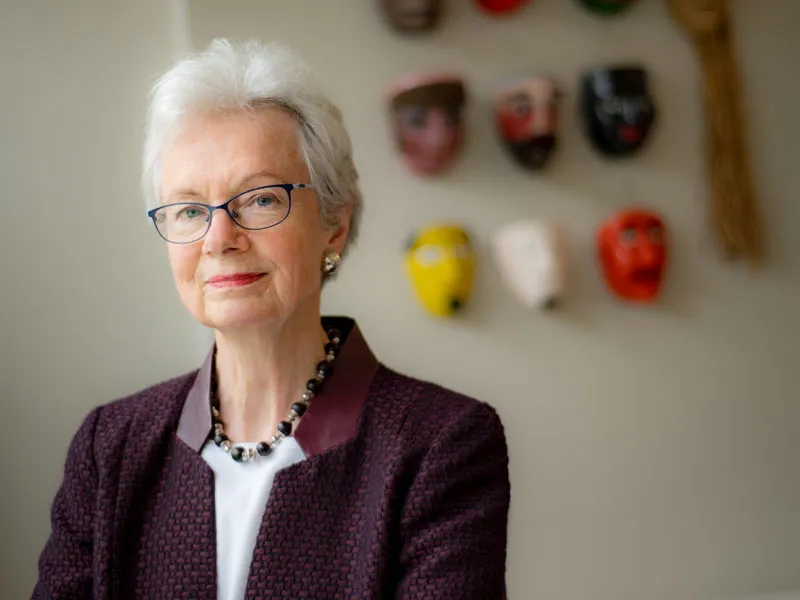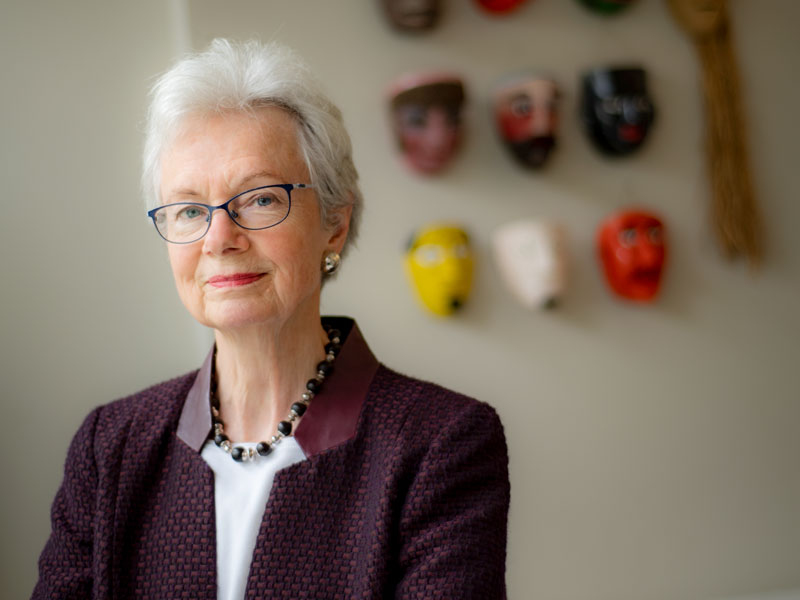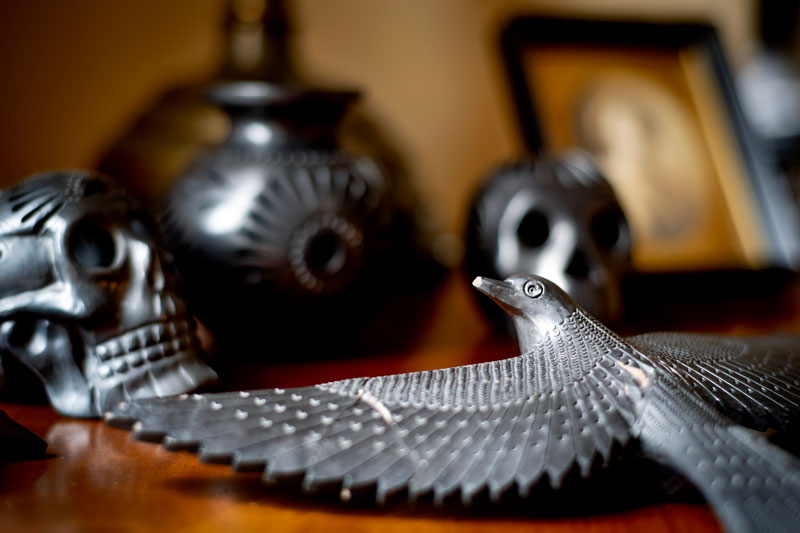

EMILY WILKERSON (EW): When did you first realize you wanted to study the history of art?
ELIZABETH HILL BOONE (EHB): I was a sophomore in college. Although I started out in marine biology, I was drawn to art. I found ancient Egyptian and Greek art to be especially compelling because these were expressions of peoples somewhat like us, but also culturally different from us.
EW: What drew you to Pre-Columbian art history, in particular?
EHB: My sculpture professor Karl Rosenberg at the College of William & Mary taught a course on ancient sculpture in which he devoted three weeks to Pre-Columbian art. I remember when he showed us the monumental sculpture of a monstrous creature—the Coatlicue sculpture, which was said to be the Aztec’s mother goddess. She was figurally horrific, with her head and hands replaced by great serpents and a skirt of intertwined rattlesnakes. I came to wonder how this could be—what kind of mind has such an image at its mother goddess? I spent some of my early career working toward the answer to that question.
EW: How does art history inform our understanding of life today?
EHB: Art history gives us the skills to see, and to evaluate what we are seeing. It trains us to look, notice difference, and judge critically. Additionally, art history tracks major historical and social movements/trends and reveals them through the visual expressions of that time. We see Egypt not through the texts of papyrus scrolls but through the pyramids, sculptures, and tomb paintings; we see the Italian Renaissance not through written documents but through the explorations and achievements—scientific as well as cultural and social—of its artists; and we see the Aztecs through their great sculptures and painted books.
Art history is the perfect disciplinary major because it draws on the approaches of history, archaeology, linguistics, literary studies, critical theory, and sociology, among others. It is ecumenical in the way it draws on different approaches to understanding visual culture. Moreover—and this is especially important today in our increasingly visual world—art history teaches us how to evaluate the way images shape our thinking and can manipulate us, for good or bad.
EW: You’ve published five books in the last ten years on writing and pictography in Mexico, in addition to numerous published articles. How does writing fit into art history—a discipline largely understood as image-based?
EHB: Artists use images to think and express themselves, but most others largely think and express themselves through language. Our expression becomes more permanent when we write it down because writing is a medium that allows discourse across location and time. We write for the future and for others not present at the moment of our writing. And, of course, this includes those who write alphabetically to record spoken languages, but also mathematicians and physicists who use algebraic notation, or composers who write musical scores.
My own intellectual project has been to understand and explain the system of Mexican pictography, and particularly how the Aztecs used figural images to record their past history, their present world, and its future possibilities. In a research project, as I begin thinking about the corpus of images I am studying, the practice of writing (and all that goes into it, from outlines to drafts) allows me to organize, analyze, and essentially make sense of these ancient human expressions. I write to solve problems, and then to convey this information to others.
EW: What are some of the changes you’ve seen in field over the 40+ years you’ve been an art historian?
EHB: In the field of art history—and much of academia—the most obvious change has been the gender rebalance. When I went to college, it was rare to have a female professor; almost all our teachers were men, and women were not taken seriously as scholars or professors. The women’s liberation movement of the late 1960s through 1980s changed this, and although women are still largely the caregivers of their children, they are also researchers and professors. Our art history program, for example, has one male professor and eleven females, five of whom are also mothers of young children.
In the field of Pre-Columbian Studies, I would say the greatest change has been the critical intervention of art historians, and not just archaeologists, as interpreters of ancient American cultures. And art history as a discipline has also changed in its goals and reach. It has transitioned from its former focus on Western Europe to a new emphasis on non-Western and global perspectives and a concern with images and objects not previously embraced in the concept of fine art. It is an exciting time to be an art historian.
EW: You’ve received awards such as Mexico’s Order of the Aztec Eagle (1990), the College Art Association’s (CAA) Distinguished Scholar (2019), and a Lifetime Achievement Award from the American Society for Ethnohistory (2019). What do these awards mean for you, your work, and your discipline?
EHB: I am very honored to have been recognized for my work, and I think also for my students’ success, of which I am very proud. It was exciting to be recognized by Mexico in 1990 for promoting Aztec culture in a path-breaking exhibition at the National Gallery of Art and a coordinated symposium on the spectacular finds when the Aztec Great Temple was just beginning to be excavated. More recently, it was especially gratifying to see the CAA recognize a Latin Americanist and Pre-Columbianist as the distinguished scholar, when 40 years prior we Latin Americanists had to fight for CAA recognition and to have even a single session on the topic at the annual meeting. This shows us how far the field has come.
I have been very fortunate to have participated in the development of Pre-Columbian and early colonial studies as a field of art historical endeavor. The Ethnohistory award, I think, recognizes the importance of insisting that Mexican pictographic writing should be understood as a discourse system roughly parallel to Western writing so that Pre-Columbian and early colonial history can be told through their painted books.
EW: What do you most love about teaching, and what has been one of your favorite moments teaching at Tulane?
EHB: I love seeing students’ eyes light up when they see and understand something entirely new, when they can read an image for the first time and come to know its cultural message, and when the material I teach challenges their assumptions about the way life is, or was. My classes usually ask students to extend beyond their own cultural perspectives. Probably the most fun is in my seminar on Mexican manuscript painting when the students study the graphic vocabulary and organizational structures of painted histories and then create their own painted histories using the ancient principles.
EW: From your perspective, why are the liberal arts important?
EHB: It is important to understand how we came to be who we are as a culture: how things from the past have shaped who we are, and how social and cultural forces in the present also determine this. For me also, it is crucial that we learn to think critically and understand how discourses of various sorts (speeches, sound bites, writings, tweets, and images) can affect us and others; and we need to be able to judge what this influence is and how we should respond to it. The liberal arts give us these skills.

Photo by Paula Burch-Celentano.
Boone’s newest book, Descendants of Aztec Pictography: The Cultural Encyclopedias of Sixteenth-Century Mexico, was published by University of Texas Press in 2021.

